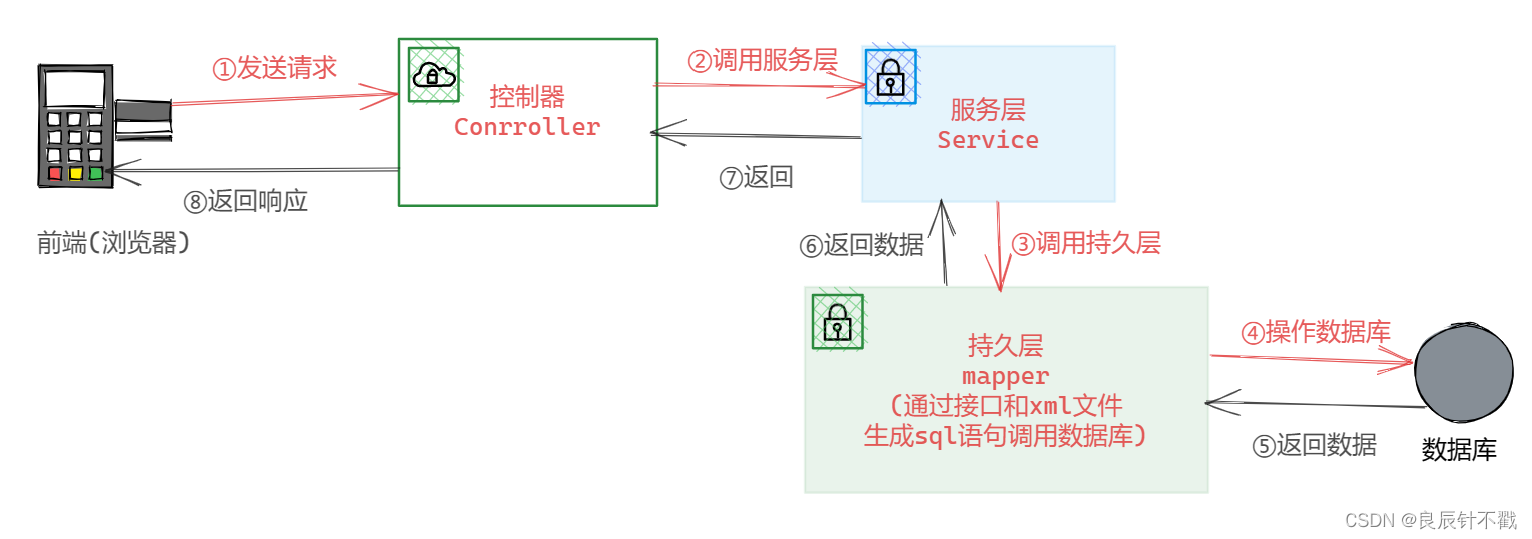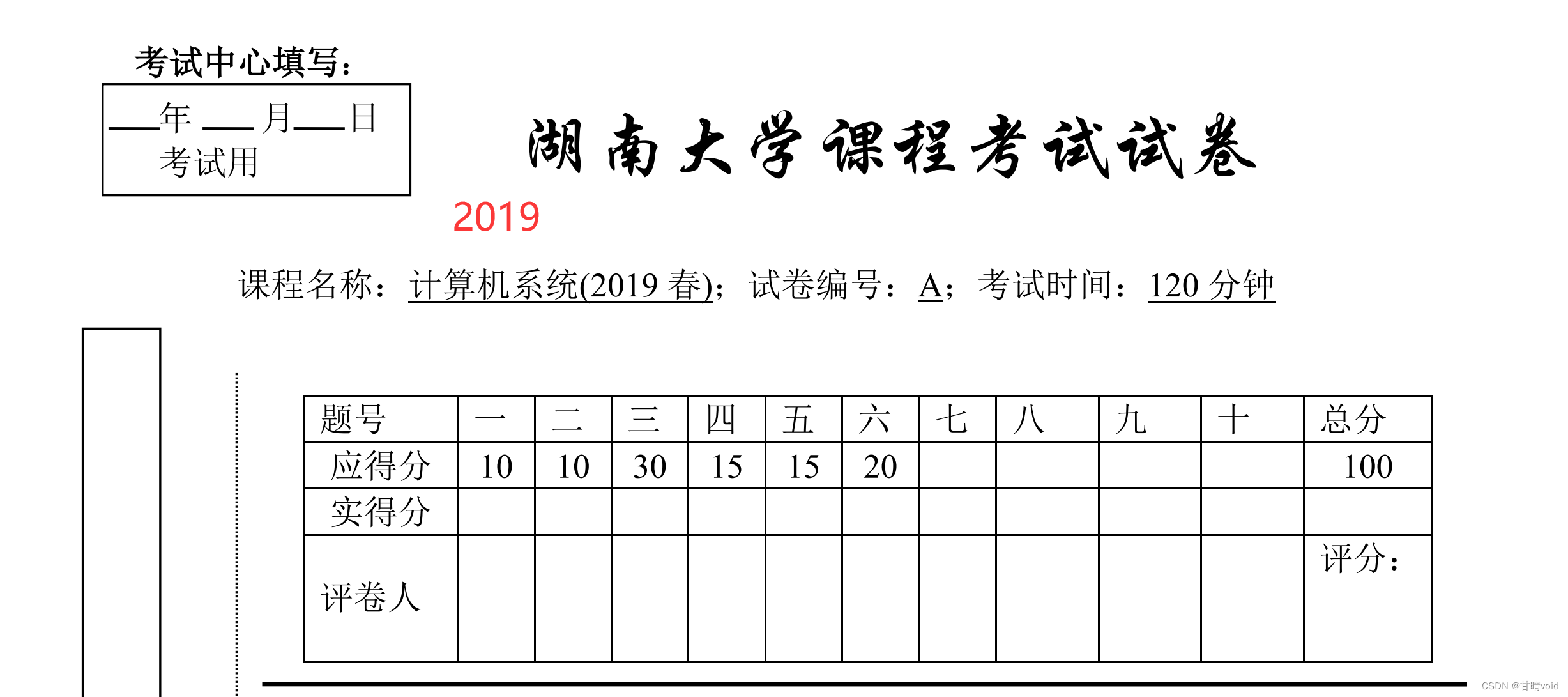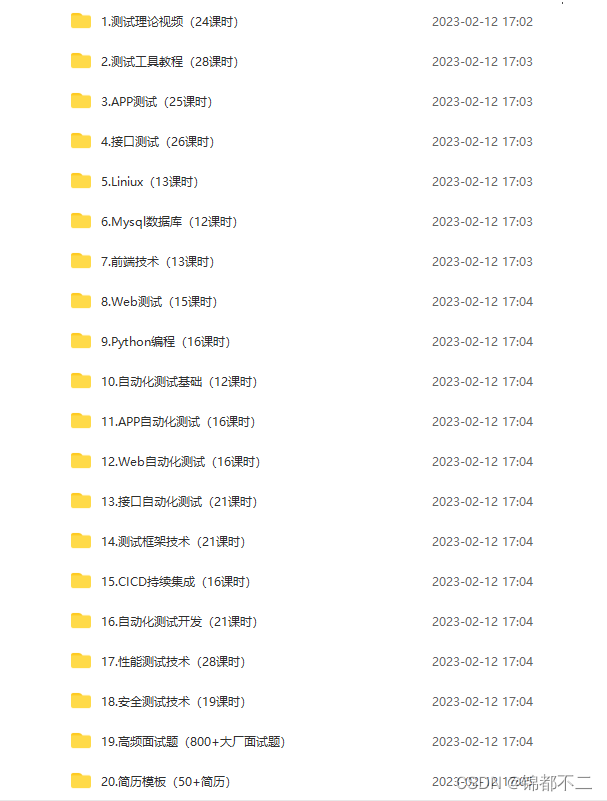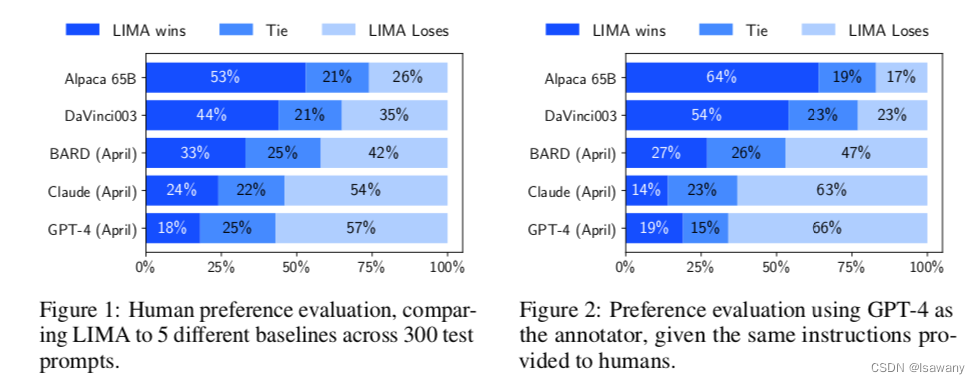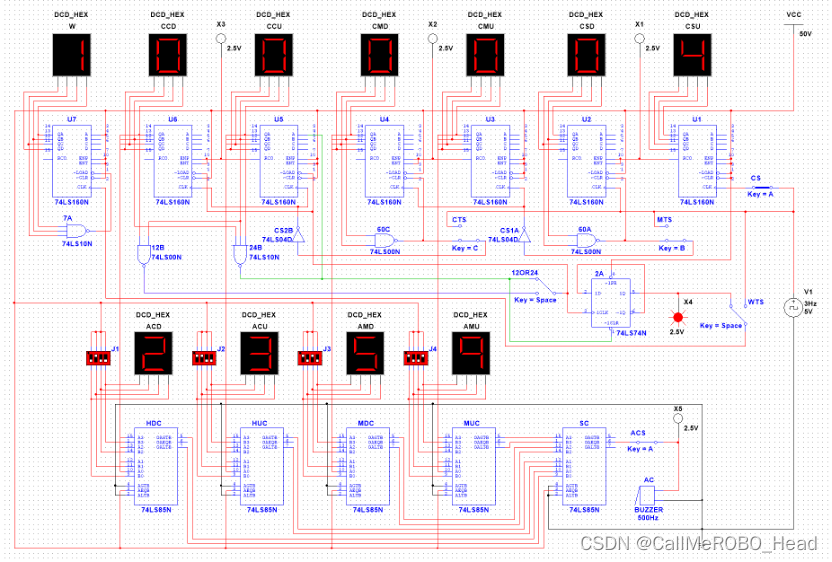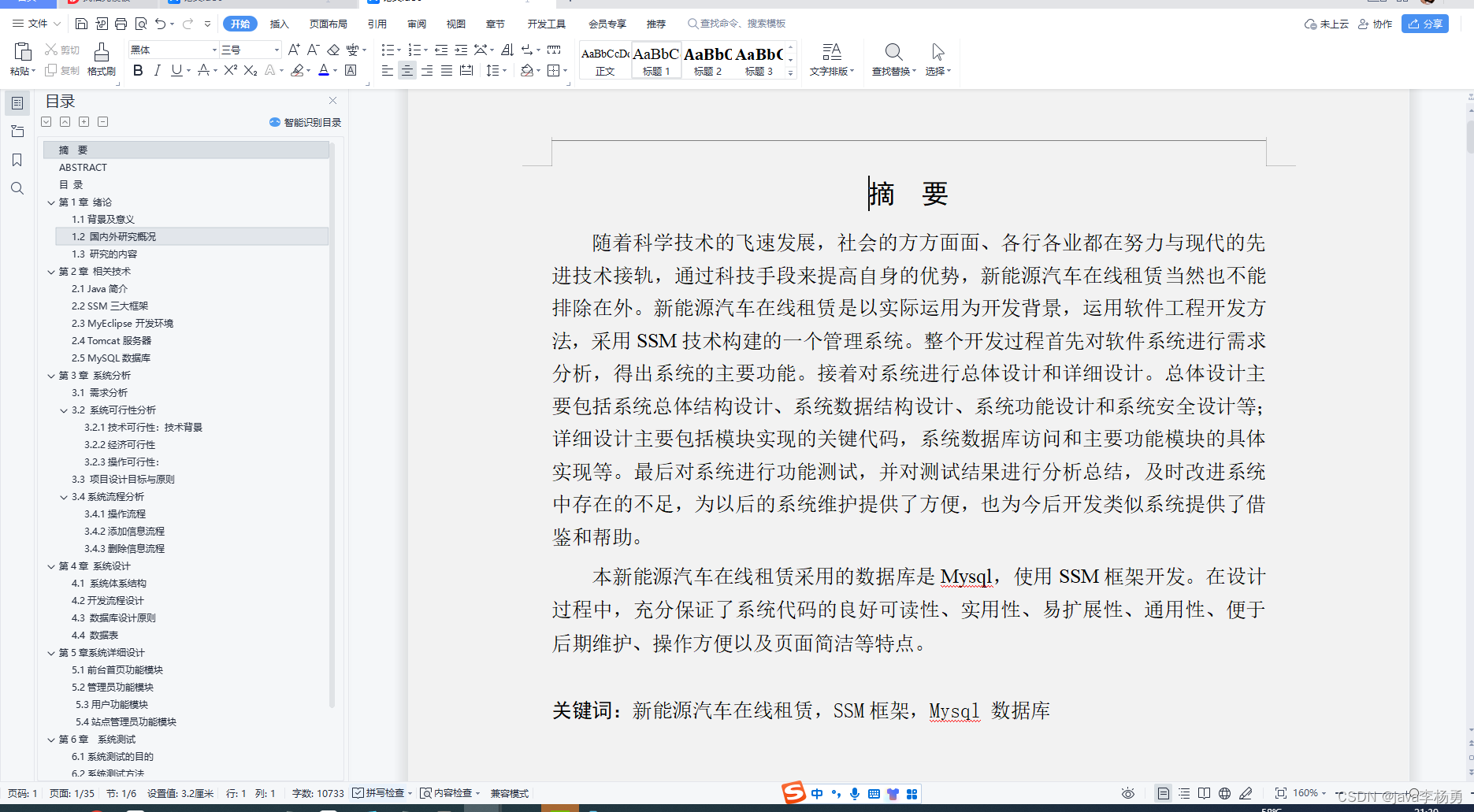文章目录
- 一、Spring Boot整合JPA
- (一)创建Spring Boot项目JPADemo
- (二)创建ORM实体类
- 1、创建评论实体类 - Comment
- 2、创建文章实体类 - Article
- (三)创建自定义JpaRepository接口 - ArticleRepository
- (四)添加数据源依赖,配置数据源属性
- 1、在pom.xml里添加阿里巴巴数据源依赖
- 2、在全局配置文件里配置数据源
- 3、在测试类里编写测试方法
- (1)注入文章仓库 - ArticleRepository
- (2)创建测试方法testFindAll()
- 练习:测试其它方法
- 二、利用JPA实现个性化操作
- (一)案例 - 根据文章编号分页查询评论
- 1、创建评论仓库接口 - CommentRepository
- 2、定义按文章编号分页查询评论的方法
- 3、创建测试类 - CommentTests
- 4、在测试类里创建测试方法
- (1)创建测试方法testFindCommentPagedByArticleId01()
- (2)创建测试方法testFindCommentPagedByArticleId02()
- (二)案例 - 根据文章编号更新作者
- 1、在评论仓库接口里编写updateAuthorByArticleId()方法
- 2、在测试类CommentTests里创建测试方法testUpdateAuthorByArticleId()
- (三)案例 - 根据评论作者删除评论记录
- 1、在评论仓库接口里编写deleteCommentByAuthor()方法
- 2、在测试类CommentTests里创建测试方法testDeleteCommentByAuthor()
- 三、利用JPA默认方法实现个性化操作
- (一)案例 - 根据文章编号更新作者
- (二)案例 - 根据评论作者删除评论记录
一、Spring Boot整合JPA

(一)创建Spring Boot项目JPADemo
配置项目

添加项目依赖
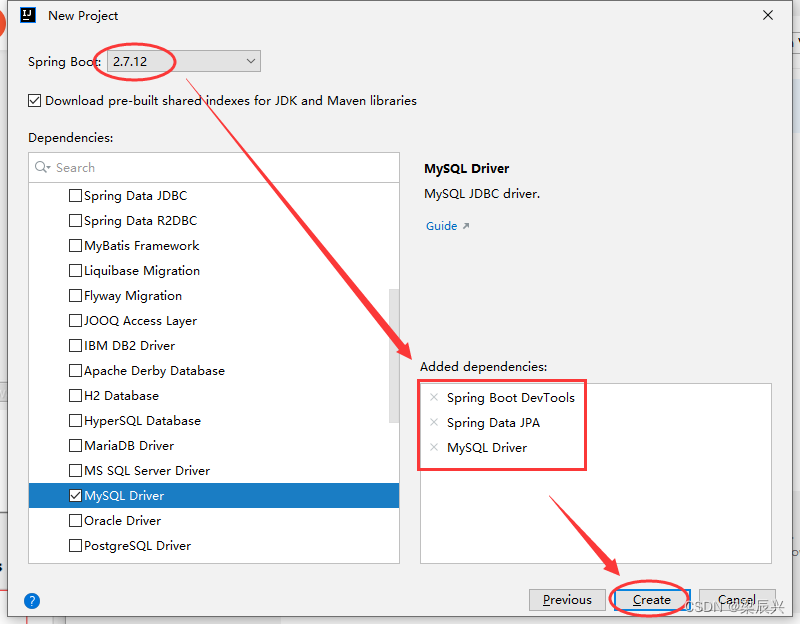
完成项目初始化工作

(二)创建ORM实体类
1、创建评论实体类 - Comment
在net.army.boot包下创建bean包,在创建Comment类
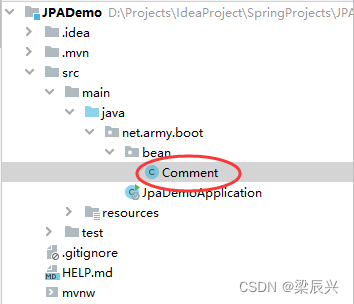
package net.army.boot.bean;
import javax.persistence.*;
/**
* 功能:评论实体类
* 日期:2023年06月13日
* 作者:梁辰兴
*/
@Entity(name = "t_comment")
public class Comment {
@Id
@GeneratedValue(strategy = GenerationType.IDENTITY)
@Column(name = "id")
private Integer id;
@Column(name = "content")
private String content;
@Column(name = "author")
private String author;
@Column(name = "a_id")
private Integer aId;
public Integer getId() {
return id;
}
public void setId(Integer id) {
this.id = id;
}
public String getContent() {
return content;
}
public void setContent(String content) {
this.content = content;
}
public String getAuthor() {
return author;
}
public void setAuthor(String author) {
this.author = author;
}
public Integer getaId() {
return aId;
}
public void setaId(Integer aId) {
this.aId = aId;
}
@Override
public String toString() {
return "Comment{" +
"id=" + id +
", content='" + content + '\'' +
", author='" + author + '\'' +
", aId=" + aId +
'}';
}
}
@Entity中的name对应数据库中表名
GenerationType.IDENTITY为MySQL中自增使用的策略,不同类型的数据库使用策略不同
2、创建文章实体类 - Article
在net.army.boot.bean包下创建Article类

package net.army.boot.bean;
import javax.persistence.*;
import java.util.List;
/**
* 功能:文章实体类
* 日期:2023年06月13日
* 作者:梁辰兴
*/
@Entity(name = "t_article")
public class Article {
@Id
@GeneratedValue(strategy = GenerationType.IDENTITY)
@Column(name = "id")
private Integer id;
@Column(name = "title")
private String title;
@Column(name = "content")
private String content;
// 查询时将子表一并查询出来
@OneToMany(fetch = FetchType.EAGER) // FetchType.LAZY 懒加载
@JoinTable(name = "t_comment", joinColumns = {@JoinColumn(name = "a_id")},
inverseJoinColumns = {@JoinColumn(name = "id")})
private List<Comment> commentList;
public Integer getId() {
return id;
}
public void setId(Integer id) {
this.id = id;
}
public String getTitle() {
return title;
}
public void setTitle(String title) {
this.title = title;
}
public String getContent() {
return content;
}
public void setContent(String content) {
this.content = content;
}
public List<Comment> getCommentList() {
return commentList;
}
public void setCommentList(List<Comment> commentList) {
this.commentList = commentList;
}
@Override
public String toString() {
return "Article{" +
"id=" + id +
", title='" + title + '\'' +
", content='" + content + '\'' +
", commentList=" + commentList +
'}';
}
}
(三)创建自定义JpaRepository接口 - ArticleRepository
创建文章仓库接口ArticleRepository
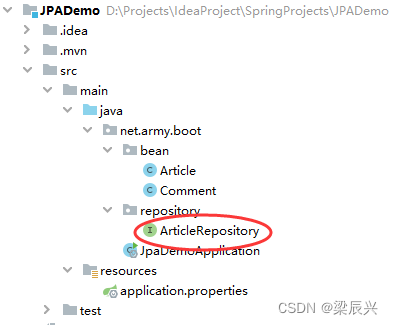
package net.army.boot.repository;
import net.army.boot.bean.Article;
import org.springframework.data.jpa.repository.JpaRepository;
/**
* 功能:文章仓库接口
* 日期:2023年06月13日
* 作者:梁辰兴
*/
public interface ArticleRepository extends JpaRepository<Article, Integer> {
}
(四)添加数据源依赖,配置数据源属性
1、在pom.xml里添加阿里巴巴数据源依赖
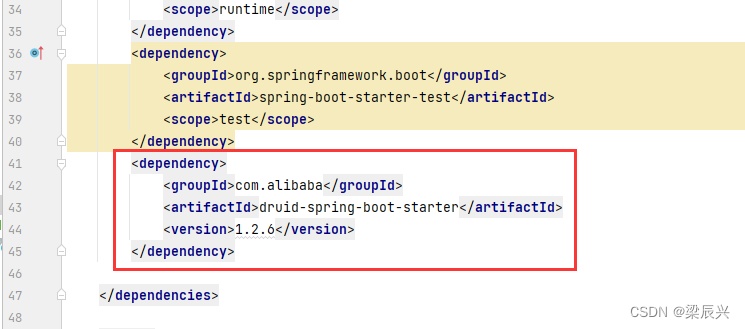
<dependency>
<groupId>com.alibaba</groupId>
<artifactId>druid-spring-boot-starter</artifactId>
<version>1.2.6</version>
</dependency>
2、在全局配置文件里配置数据源
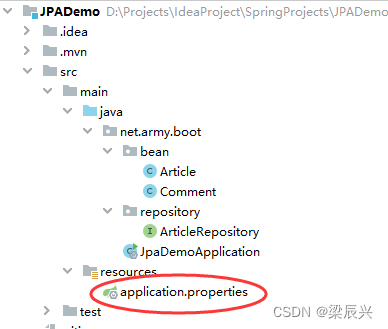

# 配置数据源
spring.datasource.url=jdbc:mysql://localhost:3306/blog?serverTimezone=UTC
spring.datasource.username=root
spring.datasource.password=root
spring.datasource.druid.max-active=100
spring.datasource.druid.min-idle=10
spring.datasource.druid.initial-size=20
3、在测试类里编写测试方法
点开项目测试类

(1)注入文章仓库 - ArticleRepository

(2)创建测试方法testFindAll()
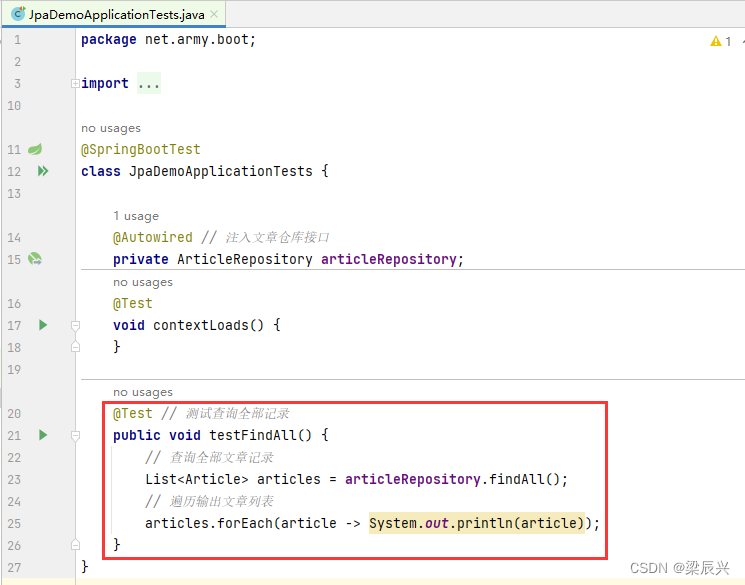
@Test // 测试查询全部记录
public void testFindAll() {
// 查询全部文章记录
List<Article> articles = articleRepository.findAll();
// 遍历输出文章列表
articles.forEach(article -> System.out.println(article));
}
运行测试方法,查看结果

练习:测试其它方法
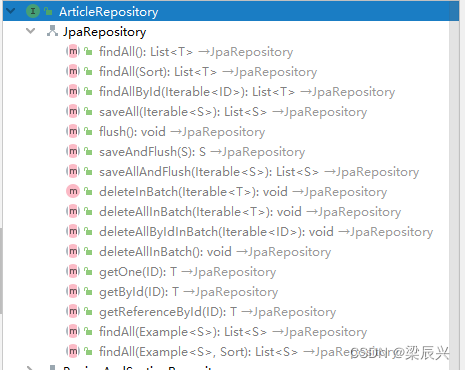
测试findById()方法
测试save()方法
测试deleteById()方法
二、利用JPA实现个性化操作
(一)案例 - 根据文章编号分页查询评论
1、创建评论仓库接口 - CommentRepository
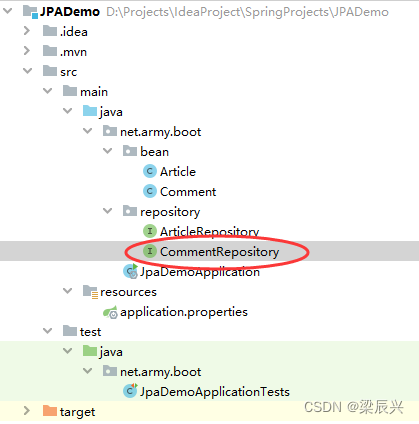
package net.army.boot.repository;
import net.army.boot.bean.Comment;
import org.springframework.data.jpa.repository.JpaRepository;
/**
* 功能:评论仓库接口
* 日期:2023年06月13日
* 作者:梁辰兴
*/
public interface CommentRepository extends JpaRepository<Comment, Integer> {
}
2、定义按文章编号分页查询评论的方法
/**
* 根据文章ID进行分页查询评论
* nativeQuery = true, 表示使用原生SQL语句,否则使用HQL语句
* @param aId 查询条件字段(文章编号)
* @param pageable 可分页对象,分页查询需要该参数
* @return 返回page对象,包含page的相关信息及查询结果集
*/
@Query(value = "select * from t_comment where a_id = ?1", nativeQuery = true)
Page<Comment> findCommentPagedByArticleId01(Integer aId, Pageable pageable);
/**
* 根据文章ID进行分页查询评论
* 没有设置nativeQuery,默认就是false,表示使用HQL语句
* @param aId 查询条件字段(文章编号)
* @param pageable 可分页对象,分页查询需要该参数
* @return 返回page对象,包含page的相关信息及查询结果集
*/
@Query(value = "select c from t_comment c where c.aId = ?1")
Page<Comment> findCommentPagedByArticleId02(Integer aId, Pageable pageable);
分页类:Pageable完整路径是org.springframework.data.domain.Pageable,导包不要导错了
两种查询方式:原生sql查询和基于对象的查询,两种方式可以任意选择一种。注意,@Query注解不设置nativeQuery属性,默认就是基于对象的查询。
基于对象的查询:@Query(value = "select c from t_comment c where c.aId = ?1"),t_comment取个别名c,可以理解为表所对应的实体,select子句不能用*,必须用c,表明查询实体的所有属性,如果要查询实体的某些属性,那么可以这样写:@Query(value = "select c.id, c.author, c.content from t_comment c where c.aId = ?1");where子句不能用表的字段名a_id,而应该用对应实体的属性aId,但是要用实体c作前缀,即c.aId。占位符:?1表示第一个占位符,当然第二个占位符就是?2。
3、创建测试类 - CommentTests

添加测试注解,注入评论仓库
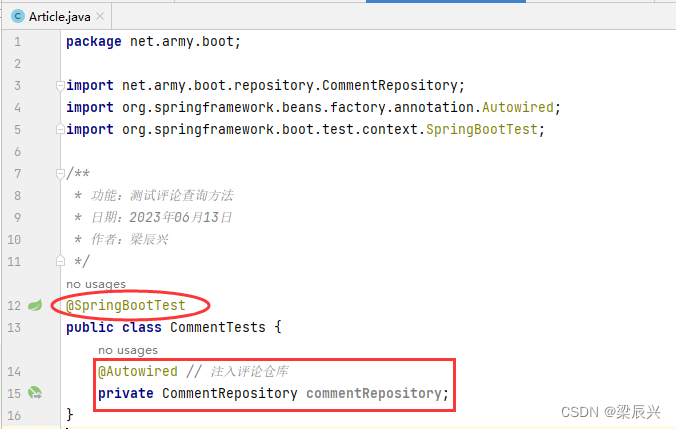
4、在测试类里创建测试方法
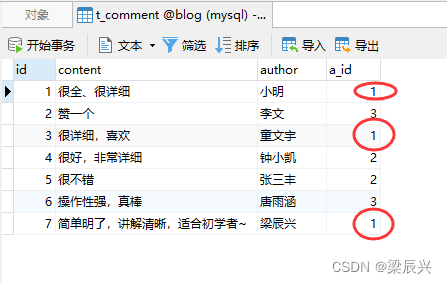
文章编号为1的评论有3条,下面我们将3条评论分两页显示,每页大小为2(最多两条记录)。第1页:id为1和3的两条评论;第2页:id为7的一条评论。
(1)创建测试方法testFindCommentPagedByArticleId01()
设置pageIndex = 0,表明当前页为第1页
设置pageSize = 2,表明每页最多两条记录
@Test // 测试按文章编号分页查询评论,采用原生SQL语句
public void testFindCommentPagedByArticleId01() {
// 当前页面索引
int pageIndex = 0; // 当前页 - 第1页
// 设置页面大小
int pageSize = 2; // 每页最多2条记录
// 创建分页器
Pageable pageable = PageRequest.of(pageIndex, pageSize);
// 查询文章编号为1的页面对象
Page<Comment> page = commentRepository.findCommentPagedByArticleId01(1, pageable);
// 获取页面对象里的评论列表
List<Comment> comments = page.getContent();
// 获取总页数
int totalPages = page.getTotalPages();
// 输出页面信息
System.out.println("当前页:" + (pageIndex + 1));
System.out.println("总页数:" + totalPages);
// 输出当前页全部评论
comments.forEach(comment -> System.out.println(comment));
}
运行测试方法,查看结果

修改页索引值为1,显示第2页评论


假如希望每页评论按照评论编号降序排列,那么该如何操作呢?
Sort.Direction.DESC - 降序;Sort.Direction.ASC - 升序
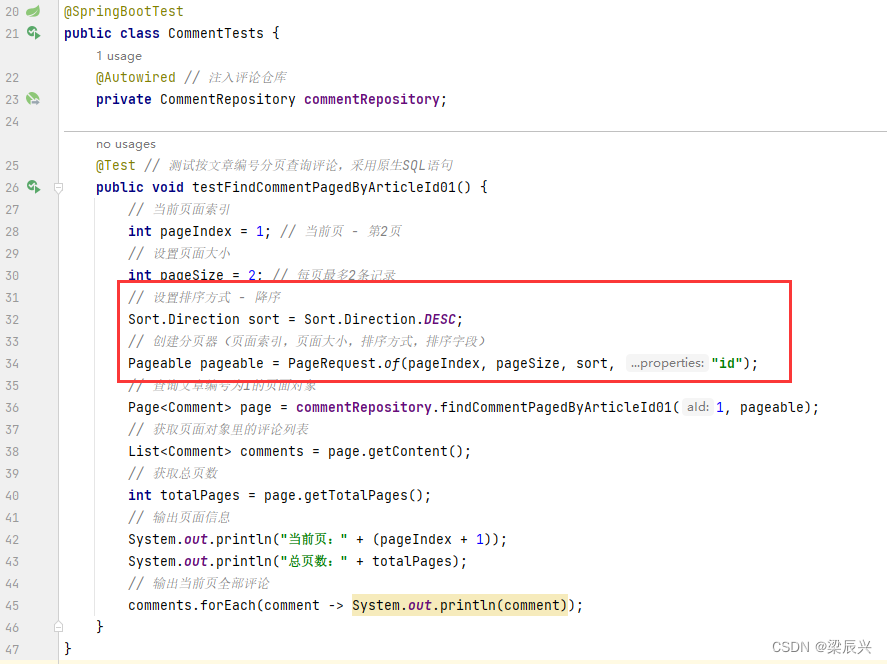
运行测试方法,查看结果

当然也可以按照评论表其它字段来排序,比如按content或author排序,大家不妨尝试一下,看看结果如何。
(2)创建测试方法testFindCommentPagedByArticleId02()

运行测试方法,查看结果

可以看到,运行结果跟testFindCommentPagedByArticleId01()测试方法最后一次运行结果是完全一样的。不论是原生sql查询还是基于对象的查询,最终分页查询的效果是相同的。
(二)案例 - 根据文章编号更新作者
1、在评论仓库接口里编写updateAuthorByArticleId()方法

2、在测试类CommentTests里创建测试方法testUpdateAuthorByArticleId()

@Test
public void testUpdateAuthorByArticleId() {
int count = commentRepository.updateAuthorByArticleId("梁辰兴", 1);
if (count > 0) {
System.out.println("恭喜,更新成功!");
} else {
System.out.println("抱歉,更新失败!");
}
}
运行测试方法,查看结果

在Navicat里打开评论表,查看文章编号为1的评论作者是不是都改成了“梁辰兴”

(三)案例 - 根据评论作者删除评论记录
1、在评论仓库接口里编写deleteCommentByAuthor()方法
2、在测试类CommentTests里创建测试方法testDeleteCommentByAuthor()

@Test
public void testDeleteCommentByAuthor() {
// 删除作者为“梁辰兴”的评论
int count = commentRepository.deleteCommentByAuthor("梁辰兴");
// 判断是否成功
if (count > 0) {
System.out.println("恭喜,评论删除成功!");
} else {
System.out.println("抱歉,评论删除失败!");
}
}
运行测试方法,查看结果

在Navicat里打开评论表,看看作者为“无心剑”的评论是否被删除了。

运行blog.sql脚本,恢复数据库blog的原始数据

注意:blog.sql文件网盘自取:
链接:https://pan.baidu.com/s/1tUMktL0UdGqT9FrLRWbkRg
提取码:cfya
三、利用JPA默认方法实现个性化操作
在生产实际中,绝大多数的功能都可用JPA提供的默认方法进行实现。
(一)案例 - 根据文章编号更新作者
在测试类CommentTests里创建测试方法testUpdateAuthorByArticleId02()
基本思路:查出所有文章编号为1的记录,然后修改作者为“梁辰兴”,再保存。
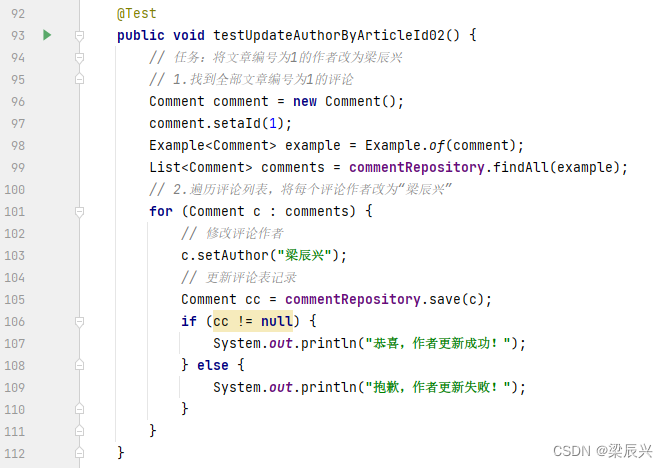
运行测试方法,查看结果

在Navicat里打开评论表,看看文章编号为1的评论作者是否都改成了“梁辰兴”

(二)案例 - 根据评论作者删除评论记录
在测试类CommentTests里创建测试方法testDeleteCommentByAuthor02()

运行测试方法,查看结果

在Navicat里打开评论表,看看作者为“无心剑”的评论是否被删除了。
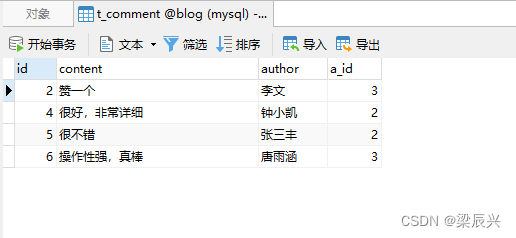
运行blog.sql脚本,恢复数据库blog的原始数据



